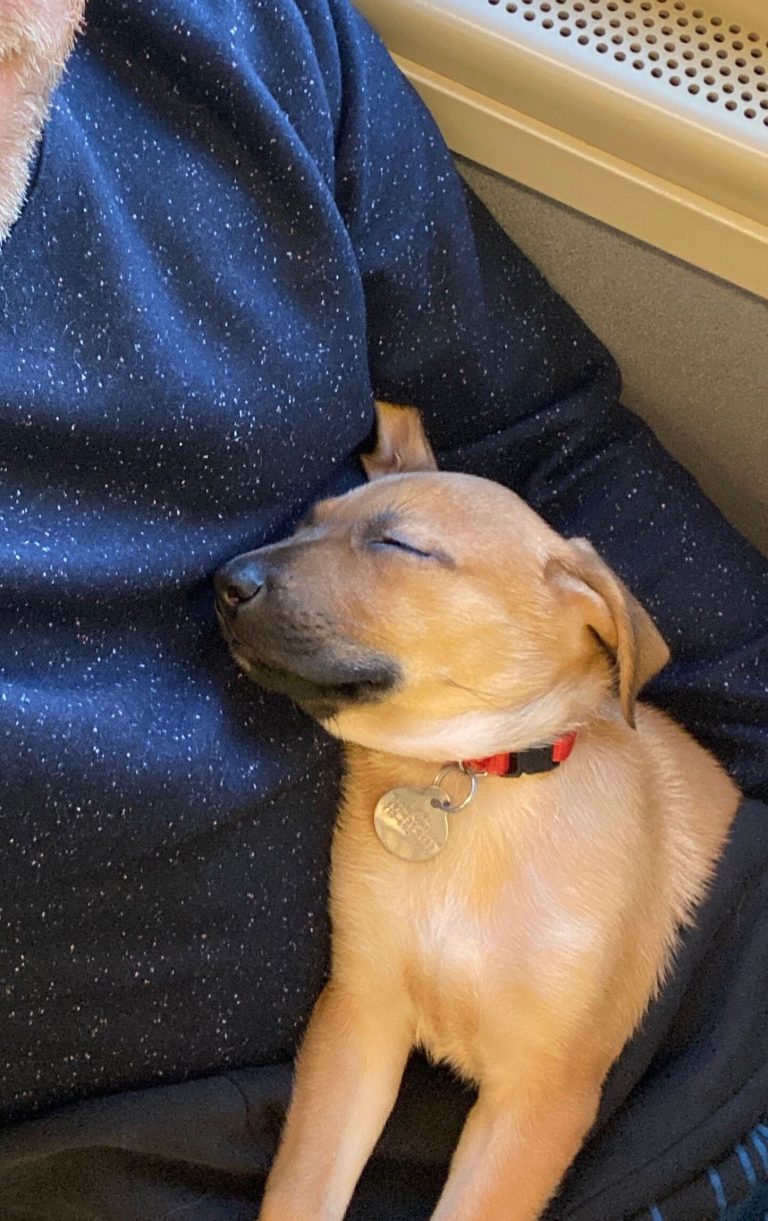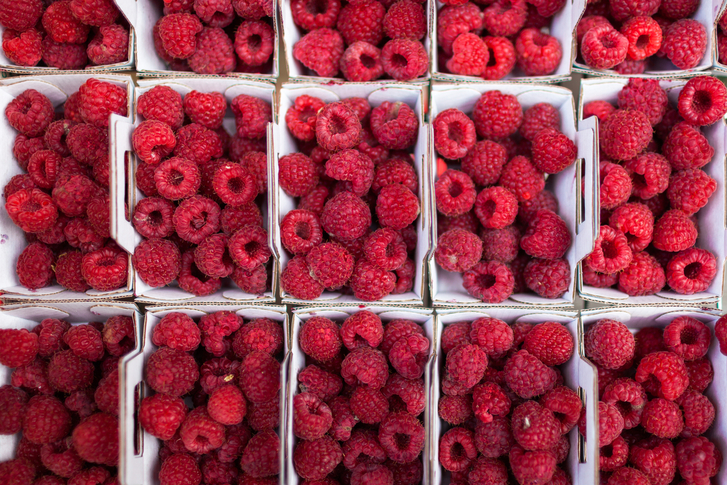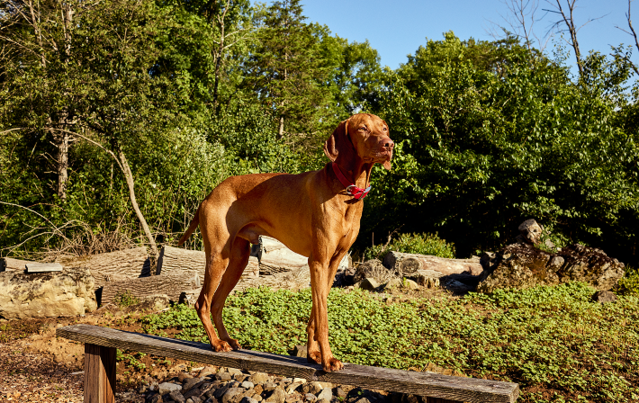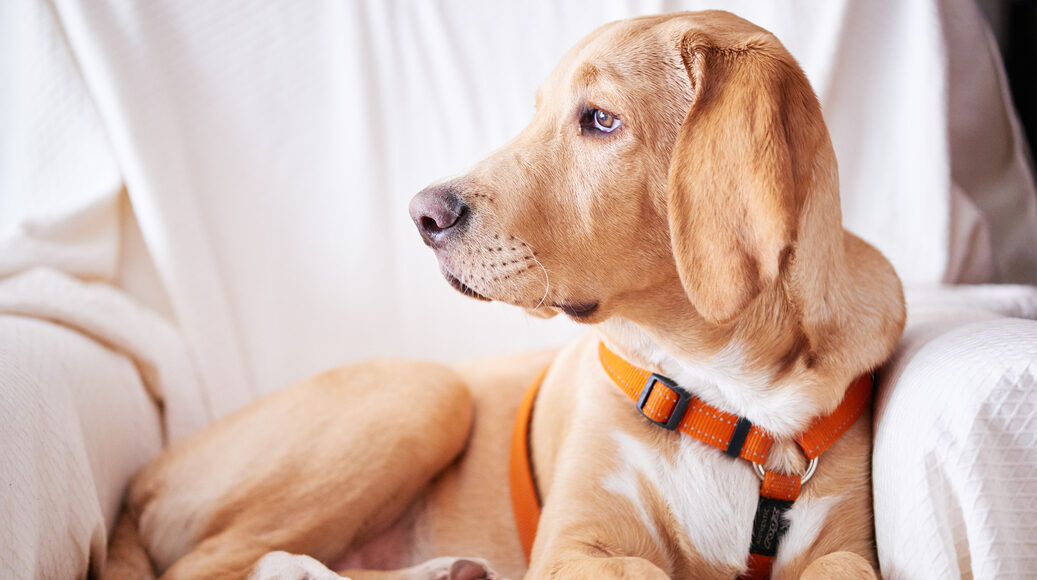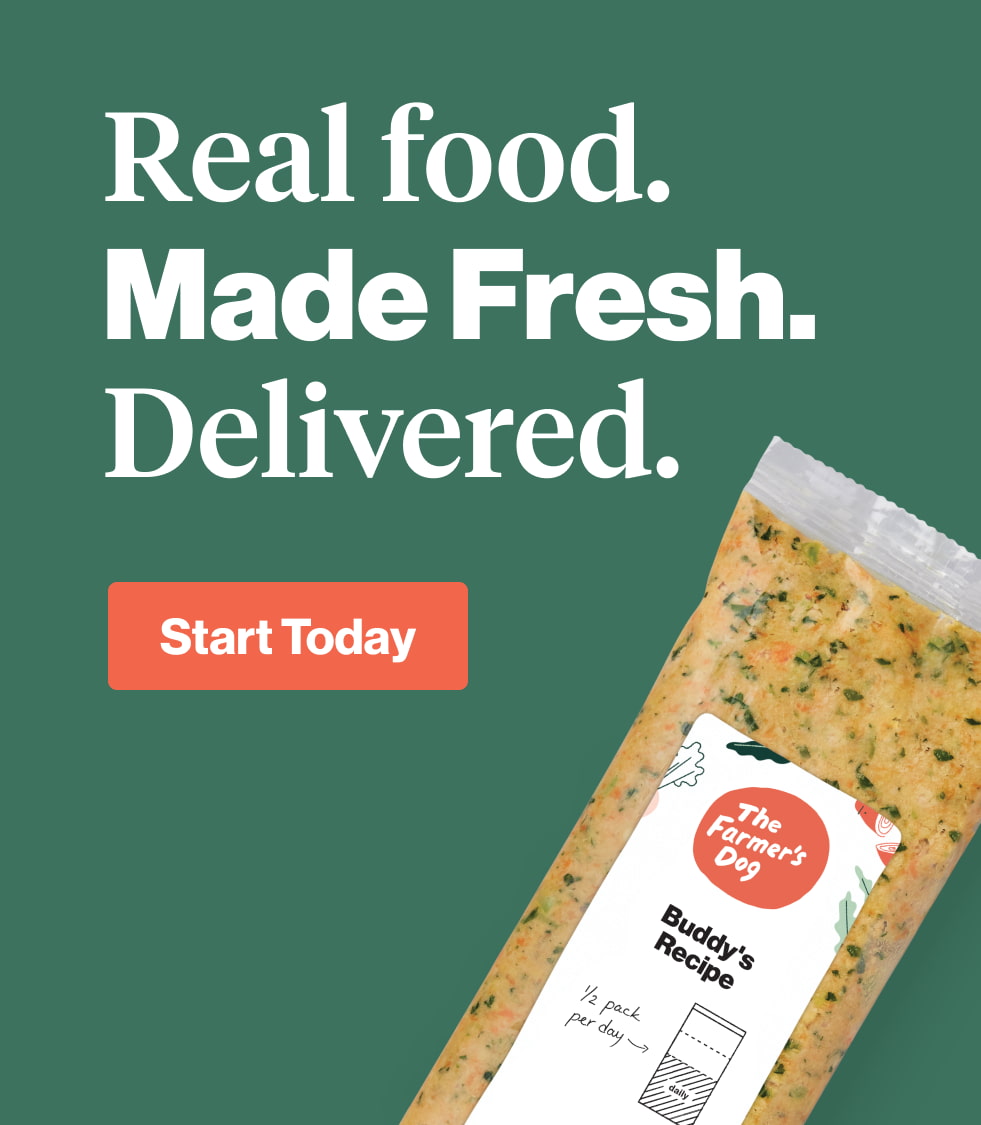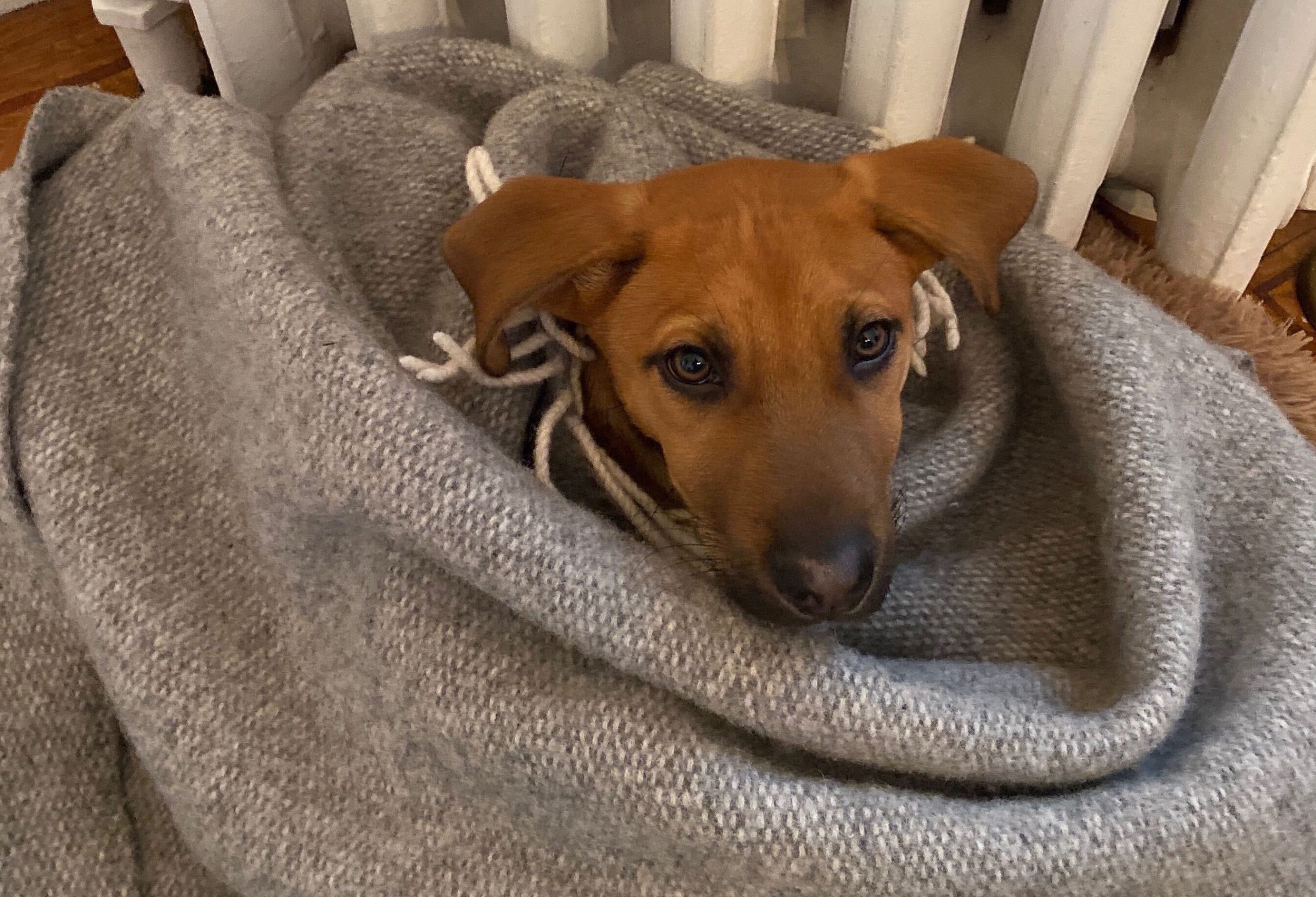
In our puppy guide, we lay out some of the key information and advice you’ll need to navigate the first several months of living with your pup. But sometimes, real life is the most valuable lesson. So we asked a (real) new puppy owner to track the first six months with their new family member, recording the milestones, the big questions and challenges, and what they most wanted to ask an expert along their puppy journey.
We hope this personal perspective, and advice on dealing with real-world issues, provide some useful insight into what works and doesn’t work for training, caring for, and living happily with your pup.
Here, George’s mom, Katie, takes us through the first six months with this unreasonably adorable fellow:
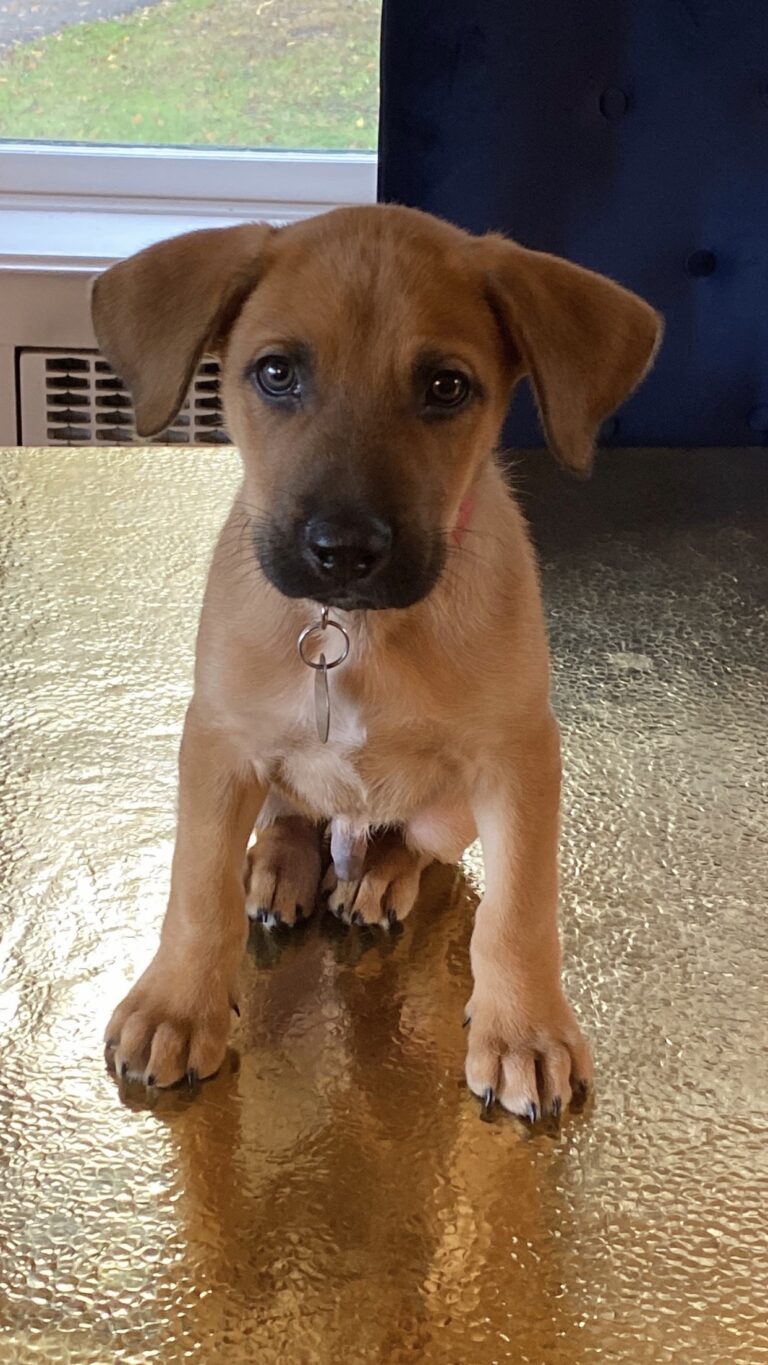
Tell us about George!
We believe he’s part Belgian shepherd (his mom was a Belgian shepherd), part boxer (because of how he uses his paws) and part Rhodesian ridgeback (he gets a ridge down his back when he gets excited). And although there are no lions to hunt in our yard, he loves stalking birds. He hasn’t figured out yet that he’ll never be able to fly…
What went into your decision to get a puppy, and to choose George? Did you feel “ready,” or was it more spontaneous?
Spontaneous! We already have one dog, Emma, and had no plans to get another. But George was just so cute and we had recently moved outside the city so could offer a house with a big yard. And then once we thought about it, we realized there were a lot more pros too—including providing a friend for Emma.
What were the biggest things you did to prepare?
My husband and I both met George to make sure his personality was right for us, and then had him visit for a night to meet our other dog, Emma. Once we decided to keep him we set him up on The Farmer’s Dog and bought a crate, harness, leash and bed. We also bought some training treats—we looked for low-calorie, fresh options.
What’s your situation re daycare?
Pre pandemic: My husband works from home two to three days a week, I work from home one day per week and I either bring George into the office with me or drop him at our local daycare for unaccounted-for days.
Post-pandemic: We are working from home!
George at 2-3 Months
The milestones
In the last two weeks he’s begun sleeping through the night!
The big questions and challenges
Katie asks: What’s normal play? We wonder about what’s OK and what’s not when it comes to biting and wrestling with other dogs.
TRAINING TIP!
Many owners assume that just because it looks like dogs are playing that it’s going to be OK. So this is a worthwhile question to ask!
Tyler Muto, founder and instructor at ConsiderTheDog.com and K9 Connection Dog Training in Buffalo, NY, says to watch for general over-excitement. “Some dogs are good when play gets super excited and they can handle it,” he says. “For other dogs, the excitement starts revving up and revving up until one of the dogs gets carried away and the other dog bites down too hard, and then before you know it the dogs are squabbling with each other.”
While your dogs are playing, practice the skill of interrupting play. “This can be as simple as making a sound like a ‘shh!’ while you move into their space. See if they can disengage with play and check in with you as you step in. Then you can go ‘OK, go ahead and play again.’ Just the act of stopping the play, hitting the pause button for a moment is very valuable. The problem is that a lot of people don’t try to do that until they absolutely need to, meaning things have already gone too far.”
Another pro tip from Muto for determining if the play is OK, or too much: Stop the play session, focusing on sidelining the more energetic dog. If one dog seems relieved to walk away, there’s your clue that the play was too much. If both dogs are game to re-engage, then play on players!
Katie asks: How do you introduce a puppy to an older dog and keep both happy?
TRAINING TIP!
Make sure you’re introducing your puppy to a stable, older dog you know—one who is calm, ideally has some experience being around puppies and isn’t a “guarder.”
Adult dogs are great teachers; you just want to make sure the learning experiences aren’t too harsh, says Blake Rodriguez, trainer and founder of Dream Come True K9 in New York. “If the puppy’s first experience is an unbalanced dog, or a dog that’s quick to correct or corrects too harshly, that sets the tone for what dogs are to them.”
If you have a stable dog, take them out for a walk or take them to an area that is not viewed as the older dog’s domain. Monitor their interaction for what might be inappropriate on the part of the older dog or if the older dog is becoming overwhelmed by the puppy. But if you have a stable older dog who is going to be relatively tolerant, says Rodriguez, the older dog will create boundaries in an appropriate way, so you can just let them be.
Katie asks: George knows he should go to the bathroom when we take him out but doesn’t know that he shouldn’t go inside. How do we communicate that’s “bad”?
TRAINING TIP!
With puppies the focus isn’t on teaching them it’s bad to go inside. What you’re really trying to do is build good habits, says Muto. And the key to them learning how to not go inside is not giving them the opportunity to go inside.
This is where crating them comes in handy. “A crate is an absolutely essential tool for potty training,” says Muto. “Crating them works because most dogs will not eliminate in their crate. The crate, or confinement, provides an opportunity for them to hold their bladder. What we really want to do is get them out as frequently as possible, and not give them unsupervised time inside.”
Katie asks: He’s been a bit itchy recently and smells kind of fishy. Does he have anal gland blockage?
VET VIEW!
Martha Cline, DVM, DACVN, Red Bank Veterinary Hospitals says: The best way to determine if he has an anal gland issue is to take him to his veterinarian. He may also be experiencing a parasitic, bacterial or yeast infection which can be best diagnosed and treated by having your veterinarian check him out.
The update: He ended up having worms! He’s all better now.
George at 3-4 Months
The milestones
His first trip!
We had a trip planned to my sister’s house in Atlanta. We felt he was too young to board so we learned all about flying with a dog. This is something we’d never done before because Emma (our other dog) is too large.
We bought a crate suitable for an airplane. Once we were at my sister’s, he had a blast playing with her dog (Emma is more aloof).
What worked and didn’t when it came to potty training?
Confinement worked!
What really helped here was getting a gate. We moved to an old Victorian house outside the city before we adopted George. It has three floors so he struggled to understand that none of the house was suitable for going to the bathroom. He would never go in his crate, but he would go into a side room or go up to the third floor to go to the bathroom. So we bought a gate and tightened the radius of the house he had access to while we trained him. That made a huge difference. We also give him a treat every time he comes inside from going to the bathroom.
How often did you feed George?
We only fed him twice a day. We felt we should feed him three times but it was just too tough with Emma (she didn’t understand why she wasn’t getting fed), plus it was difficult during the workday.
George at 5-6 Months
How often are you feeding now?
Still twice a day.
What are the new behavior issues or what really worked well in terms of core behavior/training areas?
He is incredibly good at “wait.” We test “wait” every time we feed him. Our release word is “OK!”
He isn’t very good at “out.” We took him to a few local training lessons and they taught the phrase “leave it” which he is better at but not perfect.
He’s gotten much better at “come. “We try to give a treat every time he comes and that’s helped too.
He’s OK at “down” but he still tries to lick food on the counter. Nothing we’ve tried there will stop him from trying to get food in reach if we’re not in the kitchen.
He is very happy and loving and eager to please.
What commands are you teaching and how?
We took him to a couple classes but it was too tough schedule wise with work. Our key words are: No, out, leave it, sit, down, wait, come.
As of the last month or so, he’s also somehow learned to come to a whistle. No idea where this came from but he’s better at it than the word come.
How is George with other dogs?
Pre-pandemic he loved daycare and playing with the dogs. He loves Emma so much and follows her around and tries to play with her all the time. She has warmed up and will now play some rough-and-tumble play with him (she literally never did this before at all with any dog). But she’s older so we get nervous about their play a bit because he has unbelievable agility and loves to playfully dive-bomb her!
Looking back, what did you most wish you knew—what was the biggest lesson?
Get a gate right away!
What are one or two things you’d recommend to prospective puppy owners.
Get a gate!! It’s a huge help with potty training.
Have treats. We didn’t have treats on hand before George because we hadn’t given them to Emma in years. But treats were crucial in training.
Try putting a blanket over the crate. George really liked it that way.
Have a toy box so puppies can pull out toys and amuse themselves.
It’s only hard at the beginning when they can’t make it through the night without going to the bathroom. It’s not that difficult otherwise, so I’d say, if you’re thinking about it, do it. I never thought we’d be a two-dog family but now I can’t imagine our lives without George.
Read more about puppy health, feeding, and training in our Puppy Guide!
George’s mom Katie is an employee of The Farmer’s Dog.
